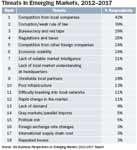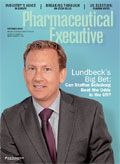Your Local Competitor: A Threat in Emerging Markets?
Pharmaceutical companies looking to wrest market share in high growth markets of tomorrow must overcome challenges from a new crop of national champions.
Emerging markets will account for 26 percent of global revenues on average for pharmaceuticals and healthcare companies by 2017, up from 15 percent today, according to the "Business Perspectives Report on Emerging Markets 2012-2017 from Global Alliance Intelligence [GIA]."

Top 10 Emerging Markets for Global Pharmaceutical and Healthcare Companies
However, a high percentage (94 percent) of pharmaceuticals and healthcare companies surveyed said they would like to have done something differently in how they planned and executed their emerging markets strategy. Many would like to have made greater efforts to enter earlier, while others would have adapted better to local conditions and prices, or ensured they had better local market intelligence and due diligence.
The survey also showed that availability, accuracy, and completeness of intelligence on emerging markets is an issue for pharmaceuticals and healthcare companies. Nearly eight out of 10 of the 38 companies surveyed said that such information is not readily available in their organizations while nearly 90 percent doubt the accuracy and completeness of the information they obtain.
One of the largest challenges to 2017 will be capturing growth in rural areas, which until now have been too fragmented to effectively enter. Global pharmaceutical and healthcare companies will also find themselves coming up against local competitors that may have the upper hand when it comes to leveraging local relationships and established procurement systems to undercut newcomers in pricing.
It could be for such reasons that the pharmaceuticals and healthcare companies in GIA's report say that local distribution and access to customers, pricing, and localized competitive positioning are their top three success factors in emerging markets over the next five years.
They also said amongst their top five threats would be competition from both local and foreign companies. The heavy hand of the government is also a major threat, with corruption and a flimsy rule of law, bureaucracy, and red tape—regulations and taxes—being the other top five threats.

Success Factors in Emerging Markets, 2012â2017
It is not difficult to see how this will be played out in reality.
Roche's Xeloda (capecitabine) is a publically-funded drug in China that is used in the treatment of metastatic breast and rectal cancers. It has become effectively "non-reimbursable" due to lack of information and some initiatives to control public health spending on prescription therapies. Public hospitals in Shanghai no longer stock capecitabine and the drug could be subjected to government-mandated price cuts (which applies to all NRDL listed drugs), without the benefit of broadened access.

Threats in Emerging Markets, 2012â2017
To address similar problems, many other companies work closely with local governments to allow for tiered pricing and other flexible approaches to establishing value by considering local socioeconomics, disease areas, viable margins, and empowering local markets to make their own decisions.
In other emerging markets, government regulations and policy are designed to favor local companies. The Russian Ministry of Industry & Energy is working towards having local players provide 50 percent of the drugs in circulation in the Russian pharmaceuticals market by 2020.
Looking ahead, pharmaceuticals and healthcare companies must be agile enough to secure effective distribution networks, navigate bureaucracies, and price effectively. What is most critical in the short-term is investment in the market research and competitive intelligence required to stay ahead of both local and foreign competitors.
Nicolas Pechet is Senior Vice President Asia Pacific at Global Intelligence Alliance. He can be reached at Nicolas.pechet@globalintelligence.com.

The Misinformation Maze: Navigating Public Health in the Digital Age
March 11th 2025Jennifer Butler, chief commercial officer of Pleio, discusses misinformation's threat to public health, where patients are turning for trustworthy health information, the industry's pivot to peer-to-patient strategies to educate patients, and more.
Navigating Distrust: Pharma in the Age of Social Media
February 18th 2025Ian Baer, Founder and CEO of Sooth, discusses how the growing distrust in social media will impact industry marketing strategies and the relationships between pharmaceutical companies and the patients they aim to serve. He also explains dark social, how to combat misinformation, closing the trust gap, and more.
Applying Porter’s Five Forces to Portfolio Management in Pharmaceutical R&D: A Strategic Roadmap
March 17th 2025The increasing costs and complexity of R&D in the pharmaceutical industry have necessitated the adoption of strategic portfolio management to optimize resource allocation and enhance competitive advantage.